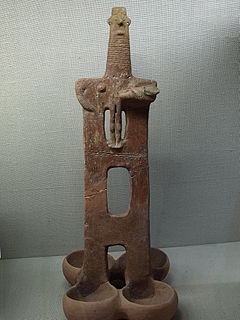 W
WThe Philia culture existed on the island of Cyprus at the start of the Early Bronze Age between 2450 and 2200 BC. It derives its name from a location in Morphou, Cyprus.
 W
WThe Prehistoric Period is the oldest part of Cypriot history. This article covers the period 10,000 to 800 BC and ends immediately before any written records of civilizations, such as the first mention of Cyprus by the Romans.
 W
WAetokremnos is a rock shelter near Limassol on the southern coast of Cyprus. It is situated on a steep cliff site c. 40 m (131.23 ft) above the Mediterranean sea. The name means "Cliff of the eagles" in Greek. Around 40 m2 (430.56 sq ft) have been excavated and out of the four layers documented, the third is sterile.
 W
WCaphtor is a locality mentioned in the Bible, in which its people are called Caphtorites or Caphtorim and are named as a division of the ancient Egyptians. Caphtor is also mentioned in ancient inscriptions from Egypt, Mari, and Ugarit. Jewish sources placed Caphtor in the region of Pelusium, though modern sources tend to associate it with localities such as Cilicia, Cyprus, or Crete.
 W
WCypriot Bichrome ware is a type of Late Bronze Age, and Iron Age, pottery that is found widely on Cyprus and in the Eastern Mediterranean. This type of pottery is found in many sites on Cyprus, in the Levant, and also in Egypt. It was typically produced on a pottery wheel. A large variety of decorations and motifs are attested. This pottery is very similar to certain types of the Mycenaean pottery from various locations.
 W
WThe Cyprus dwarf elephant is an extinct species that inhabited the island of Cyprus during the Late Pleistocene until around 11,000 years BC. Remains comprise 44 molars, found in the north of the island, seven molars discovered in the south-east, a single measurable femur and a single tusk among very sparse additional bone and tusk fragments. The molars support derivation from the Straight-tusked elephant (Palaeoloxodon antiquus), that inhabited Europe since 780,000 years ago. The species is presumably derived from the older, larger P. xylophagou from the late Middle Pleistocene who reached the island presumably during a Pleistocene glacial maximum when low sea levels allowed a low probability sea crossing between Cyprus and Asia Minor, most likely between the Karpas peninsula and Adana Province. During subsequent periods of isolation the population adapted within the evolutionary mechanisms of insular dwarfism, which the available sequence of molar fossils confirms to a certain extent. The fully developed Palaeoloxodon cypriotes weighed not more than 200 kg (440 lb) and had a maximum height of 1.40 m (4.59 ft). Whether the species extinction is to be attributed to the arrival of humans on the island remains debated. The species represented a sizable food source, but was easily overcome by contemporary hunter-gatherer populations. An association of dwarf elephant bones with human artefacts is found at the ~13,000 to 11,000 year old Aetokremnos site on the southern coast of the island.
 W
WThe Cyprus dwarf hippopotamus or Cypriot pygmy hippopotamus is an extinct species of hippopotamus that inhabited the island of Cyprus until the early Holocene.
 W
WDwarf elephants are prehistoric members of the order Proboscidea which, through the process of allopatric speciation on islands, evolved much smaller body sizes in comparison with their immediate ancestors. Dwarf elephants are an example of insular dwarfism, the phenomenon whereby large terrestrial vertebrates that colonize islands evolve dwarf forms, a phenomenon attributed to adaptation to resource-poor environments and selection for early maturation and reproduction. Some modern populations of Asian elephants have also undergone size reduction on islands to a lesser degree, resulting in populations of pygmy elephants.
 W
WEteocypriot was a pre-Indo-European language spoken in Iron Age Cyprus. The name means "true" or "original Cypriot" parallel to Eteocretan, both of which names are used by modern scholarship to mean the pre-Greek languages of those places. Eteocypriot was written in the Cypriot syllabary, a syllabic script derived from Linear A. The language was under pressure from Arcadocypriot Greek from about the 10th century BC and finally became extinct in about the 4th century BC.
 W
WLempa is a village in Cyprus located approximately 4 km (2.5 mi) north of the town of Paphos. It is sometimes written as Lemba, which is also closer to the correct pronunciation. Neighbouring villages are Empa, Kissonerga and Chlorakas.